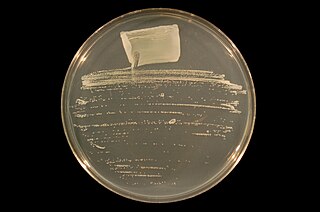
Halomonadaceae is a family of halophilic Pseudomonadota.

Cupriavidus necator is a Gram-negative soil bacterium of the class Betaproteobacteria.
Mycolicibacterium alvei is a species of the phylum Actinomycetota, belonging to the genus Mycolicibacterium.
Mycobacterium celatum is a species of the phylum Actinomycetota, belonging to the genus Mycobacterium.

Cupriavidus is a genus of bacteria that includes the former genus Wautersia. They are characterized as Gram-negative, motile, rod-shaped organisms with oxidative metabolism. They possess peritrichous flagella, are obligate aerobic organisms, and are chemoorganotrophic or chemolithotrophic. Resistance to metals has been described. These organisms have been found in both soil and in clinical isolates.
Alteromonas is a genus of Pseudomonadota found in sea water, either in the open ocean or in the coast. It is Gram-negative. Its cells are curved rods with a single polar flagellum.

Ensifer is a genus of nitrogen-fixing bacteria (rhizobia), three of which have been sequenced.
Cupriavidus metallidurans is a non-spore-forming, Gram-negative bacterium which is adapted to survive several forms of heavy metal stress.
Mycolicibacillus trivialis is a species of Mycolicibacillus. It is known to cause relapsing peritonitis.
Cupriavidus basilensis is a gram-negative soil bacterium of the genus Cupriavidus and the family Burkholderiaceae. The complete genome sequence of its type strain has been determined and is publicly available at DNA Data Bank of Japan, European Nucleotide Archive and GenBank, under the accession numbers CP062803, CP062804, CP062805, CP062806, CP062807, CP062808, CP062809 and CP062810.
Cupriavidus campinensis is a gram-negative soil bacterium of the genus Cupriavidus and the family Burkholderiaceae which was isolated in northeast Belgium. C. campinensis species were found to be highly resistant to heavy metals and antibiotics due to their genomic potentials
Cupriavidus laharis is a Gram-negative, oxidase- and catalase-positive, hydrogen-oxidizing, aerobic, non-spore-forming, motile bacterium with peritrichous flagella of the genus Cupriavidus and family Burkholderiaceae which was isolated from volcanic mudflow deposits on Mount Pinatubo in the Philippines. Colonies of Cupriavidus laharis are opaque and white.
Cupriavidus pampae is a Gram-negative, oxidase- and catalase-positive, aerobic, non-spore-forming, motile bacterium of the genus Cupriavidus and family Burkholderiaceae, which was isolated from the agricultural soil of the humid pampa region in Argentina.
Cupriavidus pauculus is a Gram-negative, nonfermentative, motile bacterium of the genus Cupriavidus and family Burkholderiaceae isolated from water from ultrafiltration systems and bottled mineral water. C. pauculus is associated with human infections.
Cupriavidus respiraculi is a Gram-negative, nonfermenting bacterium of the genus Cupriavidus and family Burkholderiaceae. It has been isolated from cystic fibrosis patients.
Cupriavidus taiwanensis is a Gram-negative, nitrogen-fixing bacterium of the genus Cupriavidus and family Burkholderiaceae, which forms indeterminate nodules on Mimosa pudica. The genome of C. taiwanensis is completely sequenced.
Bordetella hinzii is a Gram-negative, oxidase+ and catalase-positive, short rod-shaped bacterium from the genus Bordetella isolated from a patient who suffered from cystic fibrosis and from the trachea and lungs of a laboratory mouse.
Thauera mechernichensis is a bacterium from the genus of Thauera which was isolated from a landfill leachate treatment plant.
Methylorubrum suomiense is a facultatively methylotrophic and aerobic bacteria from the genus Methylorubrum which has been isolated from forest soil in Finland.
Dietzia maris is a Gram-positive and aerobic bacterium from the genus Dietzia.


